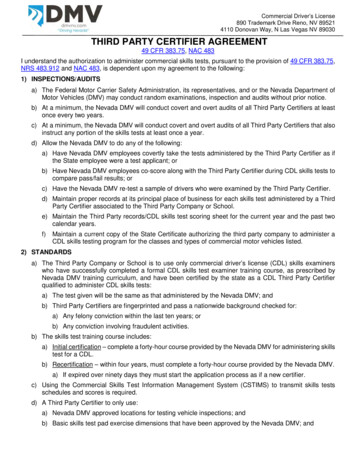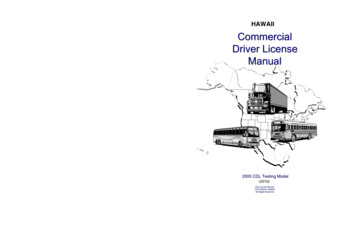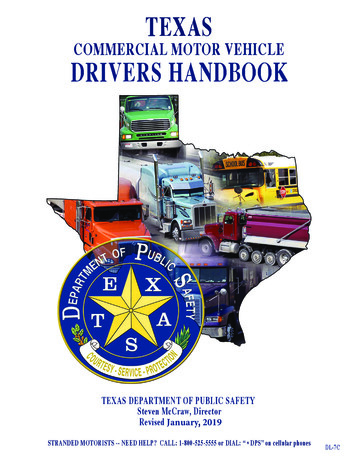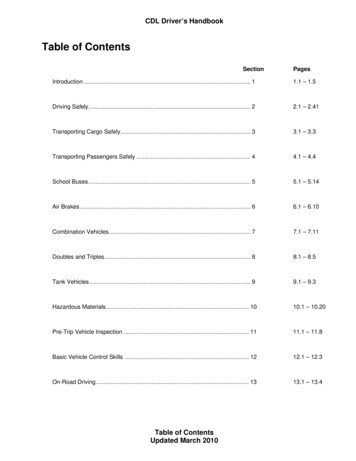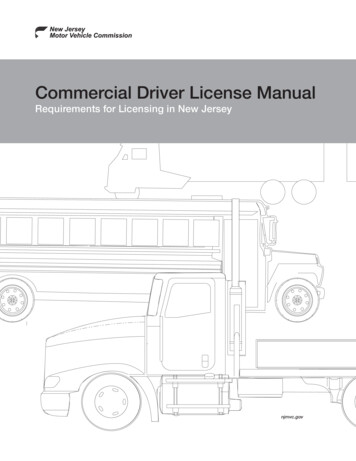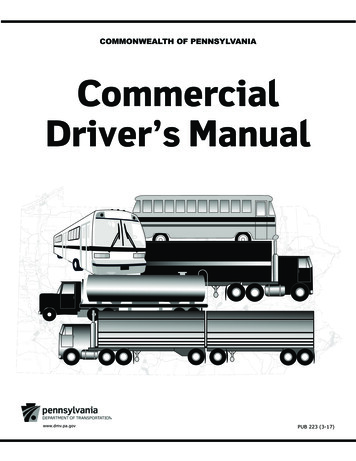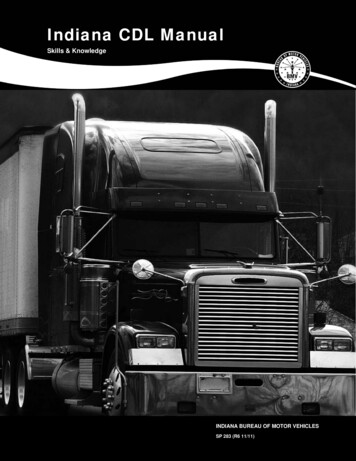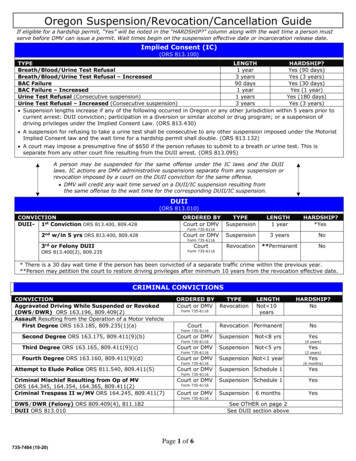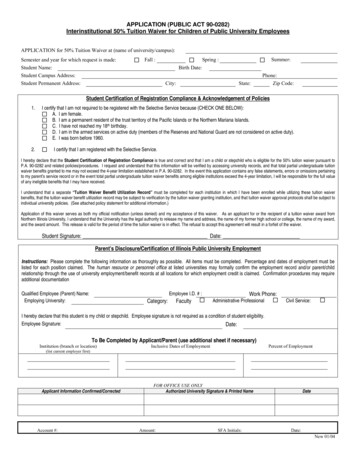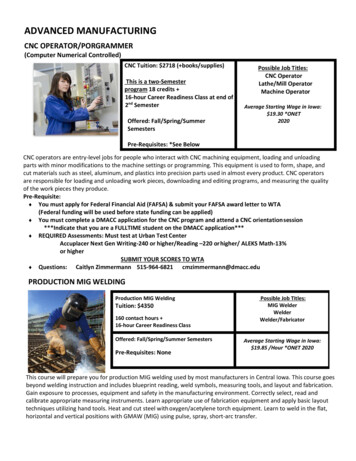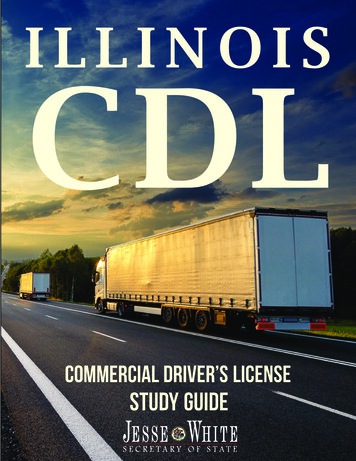
Transcription
ILLINOISCDLCOMMERCIAL DRIVER’S LICENSESTUDY GUIDE
The commercial motor vehicle industry is the backbone of ourtransportation system to ensuring goods are transported throughout Illinois and the entire country. Truck drivers are integral to theprocess and growth of our state’s economy.Illinois’ Commercial Driver’s License (CDL) program is credited asone of the best in the nation by the U.S. Department of Transportation. The CDL program, including Commercial Learner’s Permits(CLP), has been overhauled during my administration to ensurethat truck drivers licensed in Illinois are held to the highestpossible standards. Federal laws require any person applying fora CLP/CDL or current CDL holders to certify his/her commercialdriving medical status. All CLP/CDL holders who operate in non-excepted interstate commerceare also required to keep a current DOT medical certificate on file with the Secretary of State’soffice. The law strengthens the CDL program by requiring truckers meet minimum health andsafety standards before getting behind the wheel. For details on CDL/CLP medical certification,see Section 15.This year, my office initiated a law allowing for an exemption from the CDL written knowledge testfor qualified current or former military personnel who participated in military heavy-vehicleprograms. I am pleased to help make it easier for our military veterans to find employment basedon their previous military driving service.CDL applicants may schedule pre-trip, skills and on-road exams online at www.cyberdriveillinois.com.The Illinois Fast Pass program allows residents to schedule appointments online in minutes forCDL testing purposes at the CDL facility of their choice. Illinois Fast Pass can be accessed 24hours a day, seven days a week and makes scheduling CDL appointments quick and convenient.CDL applicants may also schedule appointments by calling 217-785-3013 from 8 a.m. to 4:30 p.m.,Monday-Friday.I encourage you to study this CDL Study Guide thoroughly prior to scheduling and taking therequired exams. My goal as Secretary of State is to ensure that our roads are the safest and thatwe license safe, qualified drivers to operate commercial vehicles in the state of Illinois.Sincerely,Jesse WhiteSecretary of State
ILLINOISCDL/CLPGUIDETABLE OF CONTENTSSection 1:Introduction to Illinois’ CDL .2-18Section 2:Driving Safely.19-63Section 3:Transporting Cargo Safely .64-67Section 4:Transporting Passengers Safely .68-71Section 5:Air Brakes .72-81Section 6:Combination Vehicles .82-93Section 7:Doubles and Triples .94-98Section 8:Tank Vehicles .99-101Section 9:Hazardous Materials .102-124Section 10: School Bus .125-138Section 11: Charter Bus .139Section 12: Pre-Trip Vehicle Inspection Test .140-149Section 13: Basic Vehicle Control Skills Test .150-152Section 14: On-Road Driving Test .153-157Section 15: Special CDL/CLP Information & Programs .158-170Printed by authority of the State of Illinois. February 2019 — 1 — CDL 10.201
SECTION 1INTRODUCTION TO ILLINOIS’ CDLThis Section Covers: Commercial Motor Vehicle (CMV) CDL/CLP Classifications, Endorsements andRestrictions CDL/CLP Standards and Requirements Commercial Driver’s License Tests CDL/CLP Disqualifications Other CDL/CLP Rules Mechanical Safety TestsElectronic DevicesVehicle Size LimitationsSpecial Lighting EquipmentVehicle RegistrationIRP/International Fuel Tax AgreementIllinois’ Commercial Driver’s License (CDL) program is designed to improve safety on our roads by meeting federalrequirements for testing and licensing commercial drivers. On October 26, 1986, Congress passed the CommercialMotor Vehicle Safety Act of 1986. This law sets minimum standards for the licensing of drivers of commercial motorvehicles (CMV).To obtain a CDL, you must pass all necessary knowledge and skills tests. This manual will help you pass the tests;however, it is not a substitute for a truck driver training class or program. Formal training is the most reliable way tolearn the many special skills required for safely driving a large commercial vehicle and becoming a professional driverin the trucking industry.1.1 — Commercial Motor Vehicle (CMV)A driver must obtain a Commercial Driver’s License (CDL) to operate any of the followingCMVs (unless he/she is driving these vehicles for exempted uses as noted in Subsection1.1.2 below): Any combination of vehicles with a gross combination weight rating (GCWR)** of 26,001 ormore pounds, provided the gross vehicle weight rating (GVWR)* of the vehicle being towed isin excess of 10,000 pounds. Any single vehicle with a GVWR of 26,001 or more pounds or any such vehicle towing anothernot in excess of 10,000 pounds. Any vehicle, regardless of size, designed to transport 16 or more persons, including the driver. Any vehicle required by federal regulations to be placarded while transporting hazardous materials.*GVWR — Value specified by the manufacturer as the maximum loaded weight of a single vehicle orcombination of vehicles.**GCWR — Value specified by the manufacturer as the GVWR of the power unit plus the GVWR ofthe towed unit or units.Note: For testing purposes only, the GCWR/GVWR means the value specified by the manufacturer as the maximumloaded weight of a single vehicle or combination of vehicles. The GVWR/GCWR tags must be present and legible onthe pulling unit (truck) and the trailer (if combination testing). For the skills/drive testing, a proper class representativevehicle is required. Truck-tractors of a tractor and trailer combination are not allowed for Class B testing. When appearing for the skills/drive testing, please bring all documentation for the vehicle, such as the insurance card/certificate andregistration documents, into the facility.1.1.2 — ExemptionsUnder state and federal law, certain drivers are not subject to the requirements of the CDL program. The Federal MotorCarrier Safety Administration has determined that these exemptions will not diminish the safe operation of commercialvehicles on the highways. However, these drivers are still required to possess the proper class license for the vehiclethey are operating.2
Drivers of the following vehicles are exempt from the CDL requirement: Farm Vehicle/Equipment. This exemption covers farming operations (as noted below) and does not apply tocommercial grain haulers or other types of non-farm use. This exemption only applies when farm vehicles are:— Controlled and operated by a farmer, the farmer’s family or an employee;— Used to transport farm products, equipment or supplies to or from a farm (including nurseries and aquacultures);— Used within 150 air miles of the farm; and— Not used in the operations of a common or contract carrier or for other commercial purposes.Note: Operators of Class A, truck-tractor and semi-trailer combination vehicles used expressly for farming purposesand who meet the above criteria are also exempted from holding a CDL. These drivers must still possess a Class Anon-CDL with the a J50 or J51 restriction. Drivers must be of qualifying age and must be qualified as a Farm VehicleDriver (FVD) or the vehicle(s) must meet the Covered Farm Vehicle (CFV) designation. Drivers are still required to takethe appropriate CDL written and skills/drive testing. For more information and definition, visit the Cyberdriveillinois.com,Commercial section. Emergency Equipment/Vehicle. Because most emergency organizations have extensive initial training andretraining requirements for their equipment operators, Illinois waives CDL requirements for operators of emergency equipment vehicles when responding to or returning from an emergency necessary to preserve life andproperty. Military Vehicle. Military vehicles operated by active duty military personnel. Recreational Vehicle. Recreational vehicles operated primarily for personal use.1.1.3 — Special Requirements for Certain VehiclesTo operate the following vehicles, a driver must meet special requirements established by the Illinois Secretary of Stateand/or other governmental agencies: School buses and other vehicles transporting school children for curriculum-related activities: Requires an IllinoisSchool Bus Permit (SBP) and may require a CDL with P and S endorsements. Contact the local school district/buscompany for which you plan to drive. Religious organization vehicles: Requires a J02, J03 or J04 restriction. Vehicles exclusively for transporting senior citizens: Requires a J05, J06 or J07 restriction. Non-profit ride sharing or child care vehicles.These vehicles may or may not require a CDL, depending on the number of passengers the vehicle is designed totransport or the GVWR of the vehicle. For more information on operating these types of vehicles, drivers should checkwith their employer, a local Driver Services facility or call the Safe Ride Section at 217-785-2543.1.2 — Commercial Driver’s License (CDL) and Commercial Learner’s Permit (CLP) Classifications, Endorsements and RestrictionsCDL and CLP classifications, endorsements and restrictions are based on the type of CMV driven. The type of CMVis determined by the manufacturer’s GVWR/GCWR, construction or use.1.2.1 — Driver’s License Classifications (CDL and NON-CDL) Class A — Combination vehicles with a GCWR** of 26,001 or more pounds, provided the GVWR* of the vehiclebeing towed is in excess of 10,000 pounds. Class B — Single vehicle with a GVWR* of 26,001 or more pounds or any such vehicle towing another not in excessof 10,000 pounds. Class C — Single vehicle with a GVWR* of at least 16,001 pounds but less than 26,001 pounds. Class D — Single vehicle with a GVWR* of less than 16,001 pounds.GCWR** — Gross Combination Weight RatingGVWR* — Gross Vehicle Weight Rating3
1.2.2 — CLP and CDL Endorsements P — Passenger Vehicles: CLP & CDL. N — Tank Vehicles: CLP & CDL. S — School Bus: CLP & CDL. H — Hazardous Materials: CDL only. X — Combined Hazardous Materials & Tank Vehicle: CDL only. T — Double & Triple Trailers: CDL Class A only. C — Charter Bus: Illinois CDL only.1.2.3 — CLP and CDL Type Restrictions B — Corrective lenses required (CLP & CDL). E — Automatic Transmission only in CDL/CMV (CDL only). F — Outside Mirrors and/or hearing aid (CLP & CDL). K — CDL Intrastate Only (CLP & CDL). L — Air Brakes not allowed (CLP & CDL). M — Class B or C Passenger vehicles only (CDL only). N — Class C Passenger vehicles only (CDL only). O — No Tractor Trailer CDL/CMV (CDL only). P — No Passengers in CDL/CMV bus (CLP only). V — FMCSA (federal) medical variance (CLP & CDL). X — No cargo in a CDL/CMV Tank vehicle (CLP only). Z — No full Air Brakes equipped CDL/CMV vehicles (CDL only). J10 — CDL vehicles with GVWR 16,000 lbs or less (Illinois Class C CDL only). J50/J51 — Farm waived truck tractor-semi trailer vehicles (visit cyberdriveillinois.com for definition and eligibility –Illinois Non-CDL Class A only).A driver’s DL, CLP or CDL may contain other restrictions not listed above based on specific conditions for each driver.1.3 — CDL and CLP Standards and RequirementsTo get an Illinois CDL or CLP, you must comply with the following standards and requirements.1.3.1 — Documentation Required for a CLP/CDLAs is required for any driver’s license, all new or transferring CDL applicants are required to show documentation verifying their identity, date of birth, Illinois residency, signature and Social Security number. For the most up-to-date listof acceptable documents, please visit www.cyberdriveillinois.com.Effective July 1, 2015, federal law requires all new CDL and CLP applicants to provide proof of citizenship or lawfulpresence. Existing CDL holders wishing to renew or upgrade their CDL will also be required to provide proof of citizenship or lawful presence to the driver facility staff to be able to renew or upgrade. Refer to the above website for acceptable citizenship (certified birth certificate or valid passport) and lawful presence documents.1.3.2 — CDL/CMV Medical Program RequirementsMost operators of commercial vehicles with a gross motor vehicle weight of 10,001 pounds or more are required tocarry a Medical Examiner’s Certificate at all times while operating a second division vehicle. All non-excepted interstatedrivers are required to submit their medical examiner’s certificate to the Secretary of State. For additional medicalexaminer reporting requirements and information, please refer to Section 15.Do I Need a DOT Medical Card?Yes, if you are a non-excepted driver who will: Operate a commercial vehicle with a gross vehicle weight rating (GVWR) or a gross combination weight rating(GCWR) of 10,001 pounds or more in the furtherance of a commercial enterprise (private or for hire). Operate a passenger carrying vehicle designed to transport eight or more passengers, including the driver. Operate any vehicle transporting hazardous materials of a quantity that would require placarding.4
CDL Medical CertificationInitial medical certification with the Secretary of State’s office can only be processed at one of the 47 CDL Driver Services facilities (see Pages 8 and 9). After your original certification in person, you may visit any Driver Services facilityto obtain a duplicate/corrected CDL or renew your license when only a vision test is required.If you are a non-excepted interstate (NI) driver, upon expiration of your current medical examiner’s certificate, you mustpresent an updated certificate at a CDL facility or mail it to the CDL Medical Unit in Springfield. A reminder letter is sentto all NI drivers 90 days prior to the expiration of the current medical examiner’s certificate. If the certificate is presentedto a CDL facility, your medical status will be updated immediately. If mailing the new certificate, please do so 30 daysprior to the expiration of your current certificate. If you allow your medical examiner’s certificate to expire and have notchanged your medical certification category status with the Secretary of State, your CDL driving privileges will be canceled. If you have any questions involving the CDL Medical Program, please call 217-785-3002.The Secretary of State’s office is not responsible for regulating or enforcing these federal or state medical programregulations (other than recording the self-certification of CLP/CDL holders and the medical information for NI drivers)and may not have the forms necessary for compliance with these regulations. Enforcement is the responsibility of theIllinois State Police and/or IDOT.All required medical forms and informational material are available at cyberdriveillinois.com or FMCSA.gov or the following organizations:J.J. Keller & Associates, Inc.3003 W. BreezewoodNeenah, WI 54956800-327-6868Illinois Trucking Association932 S. Spring St.Springfield, IL 62704217-789-6017Mid-West Truckers Association2727 N. Dirksen Pkwy.Springfield, IL 62702217-525-0310Illinois Trucking Association7000 S. Adams, Ste. 130Willowbrook, IL 60527630-654-08841.3.3 — Additional RequirementsIn addition, commercial vehicle drivers must: Maintain and have in their possession a file that contains their written exam verification, driving exam verificationand other records. Be at least age 21 to drive a commercial motor vehicle involved in interstate commerce or transport passengers. Be at least age 18 to obtain a CLP/CDL and/or to transport hazardous materials intrastate (within Illinois only). Certify that they do not have more than one driver’s license and that their driving privileges are not suspended,revoked, canceled or disqualified. Certify that they meet the medical requirements of the Federal Motor Carrier Safety Regulations or that theyare not subject to the regulations.For more information regarding the Motor Carrier Safety Regulations, see Table C in Section 15, visit fmcsa.dot.gov orcontact:Illinois Department of TransportationCommercial Vehicle Safety SectionMotor Carrier Safety Unit3215 Executive Park Dr.Springfield, IL 62703217-785-11815
1.3.4 — CDL Transfer and CLP Requirements CDL applicants who transfer their CDL to Illinois from another state must pass all applicable CDL knowledge andskills/drive tests to obtain an Illinois CDL and any endorsements, regardless if they held an Illinois CDL previously. An initial Commercial Learner’s Permit (CLP) must be held for at least 14 days before skills/drive testing can beconducted. Any changes to the initial CLP will require a new 14-day waiting period. A CLP issued to an applicant to upgrade to a higher class CDL, remove the air brakes restriction, or add a passenger endorsement or a School Bus endorsement must be held for at least 14 days before the skills/drivetesting can be conducted. A CLP expires 180 days from the date of initial issuance or renewal. A CLP can be renewed for an additional180 days without additional written testing if renewed within five calendar days from the date of expiration. ACLP can be renewed up to 30 days in advance of expiration for an additional 180 days. All CLP renewals willrequire the full CLP fee. Upon renewal of a CLP, any completed skills/drive testing must be re-taken. A CLP may not be renewed a second time. An applicant who wishes to retain a CLP more than 360 days afterinitial issuance is required to pay a new CLP fee and complete all applicable testing.1.3.5 — MCSIA RuleAll CDL holders are required by federal law to submit to a one-time 10-year driving history check on renewal or surrenderof an out-of-state license to obtain an Illinois CDL. CDL holders applying for a corrected or duplicate license also arerequired to submit to a one-time 10-year driving history check.1.3.6 — CDL/CLP Fees The renewal and out-of-state transfer fee (18-69 years of age) for a CDL is 60. This includes 10 for thebasic driver’s license, 24 for the CDL, 6 to cover the cost of the nationwide CDLIS program and 20 for theMotor Carrier Safety Inspection Fund. After age 69, CDL holder renewal fees decrease due the driver’s age. The fee for a CLP is 50 for all non-CDL license holders or to renew an initial CLP. The fee to upgrade an existing CLP/CDL class or to add/remove any endorsement/restriction is 5.1.4 — Commercial Driver’s License Tests1.4.1 — Computerized Written Knowledge TestingYou will have to take one or more computerized knowledge tests, depending on the class of license and endorsementsyou want. Figure 1.2 shows the sections of this manual you should study for each class of license and each endorsement.WHAT SECTIONS SHOULD YOU STUDY?License TypeEndorsementSection toStudyClass A Class B Class C Hazardous Double Tank Passenger School Bus Charter Bus123 MaterialsTriple Vehicles 45*678 9** 10111213146 Figure 1.2 *Study Section 5 if you plan to operate vehicles equipped with air brakes.**TSA Hazardous Material Endorsement approval is also required priorto testing.
All CDL applicants are required to pass the general CDL (core) knowledge written test, with a minimum score of 80percent. This exam consists of 30 standardized multiple-choice questions. Written knowledge tests are valid for the maximum of one year.Additional knowledge and endorsement exams include: Combination: Required for applicants to operate a Class A combination/articulated vehicle (20 questions). Air Brakes: Required for applicants to operate a vehicle equipped with a full or partial air brakes (air-overhydraulic) system (25 questions). Passenger endorsement (P): Required for applicants to operate a vehicle that is designed to transport 16 people or more (20 questions). Tank Vehicle endorsement (N): Required for applicants to operate any commercial motor vehicle that isdesigned to transport any liquid or gaseous material within a tank(s) that is/are either permanently or temporarilyattached to the vehicle or the chassis, where each tank has a individual rating capacity in excess of 119 gallons,and where all tanks have an aggregate total of 1,000 gallons or more (20 questions). School Bus endorsement (S): Required for applicants to operate a yellow school bus in any state to transportschool children grades 12 and under in any state for school-sponsored activities (20 questions). Note: This testis also required for a driver to obtain a School Bus Permit (SBP), which is required for a driver to operate anyvehicle on behalf of a school transporting Illinois school children grades 12 and under for curriculum-relatedactivities. If the driver requires both the S endorsement and the SBP, then only one school bus knowledge testwill be required. Note: Neither the S endorsement nor the SBP is required to operate an empty yellow schoolbus, but a P endorsement is required for any bus designed to transport 16 or more people. Hazardous Materials endorsement (H): Required for applicants to operate a vehicle transporting hazardousmaterials requiring placards, as defined in 49 CFR 383.5 (30 questions). Prior to this test, the applicant mustsubmit to a Transportation Security Administration (TSA) background check (separate/additional fee required)and receive an approval letter. For more information, contact 855-DHS-UES1 (855-347-8371) or visit https://universalenroll.dhs.gov/#hme-home. Doubles/Triples endorsement (T): Required for drivers to operate a vehicle pulling double or triple trailers (20questions). Charter Bus endorsement (C): Required for Illinois applicants to operate a charter-type bus when transportingschool children grades 12 and under on behalf of an Illinois school district for school activities of any type. If thedriver already holds both an S endorsement and an SBP for the same class as the charter bus, no C endorsement is required (20 questions).1.4.2 — Skills/Drive TestingAfter successfully passing the required written test(s), most applicants will be required to pass the skills/drive testing.There are three general skills that will be tested: pre-trip vehicle inspection, basic vehicle control and on-road driving.An applicant who has successfully passed one part but then fails a subsequent part is not required to retake the partpassed. For example, a driver who successfully completes the pre-trip inspection, but then fails the basic control skillsis not required to retake the pre-trip inspection. If applicants fail a part of the skills/drive testing (ex: pre-trip inspection),they must perform the entire pre-trip inspection during their next exam.1) The pre-trip inspection test is conducted to determine whether the applicant knows how to properly inspect thevehicle to determine if it is safe to drive. Applicants will be asked to conduct a pre-trip inspection of a representativevehicle they will operate on the job. The examiner will inquire about a certain area on the vehicle(s), and the applicantmust explain what is to be inspected and why. Applicants will be scored section by section of the vehicle, and an applicant who accumulates a predetermined amount of points for a particular section will fail the pre-trip inspection. Applicants will not be tested on any component or area that is not present on the vehicle used for the test nor will they berequired to get under the vehicle to examine any components; however, they must point out these components andexplain why it is necessary to inspect those components. If a component of the vehicle examined during the pre-tripinspection fails to work properly through no fault of the applicant, the test may be discontinued, but the vehicle component failure will not be scored against the applicant. If the driver will be operating a vehicle with air brakes while onthe job, the test vehicle must be equipped with air brakes. See Sections 2.1 and 12 of this study guide for additionalinformation regarding the pre-trip inspection.7
2) The basic vehicle control skills test is conducted to evaluate an applicant’s ability to use basic skills to control thevehicle. All applicants must complete three exercises on the facility course/road marked by lines, traffic cones or similarboundaries. These exercises test the applicant’s ability to move the vehicle forward, park the vehicle, move backwardand reverse dock the vehicle. Applicants are scored on how well they stay within the boundaries outlined by the examiner,how many pull-ups and looks are used and how well they maneuver the vehicle into its final position. Applicants shouldavoid contact with any cones or boundary lines and should not cause a dangerous action within the testing area or exceedthe accumulated overall point limit.3) The on-road driving test is conducted to evaluate the applicant’s ability to drive safely in a variety of on-road situations. The road test route will include left and right turns, intersections, railway crossings, curves, upgrades, downgrades, rural or semi-rural routes, multilane city streets and/or expressway driving. Applicants will be scored on eachof these driving maneuvers and conditions and must not exceed a predetermined number of points assigned to thedriving exam, cause any dangerous action or violate any laws during the exam. Any driver who fails the road test sixtimes will be required to submit an Illinois medical report before attempting any additional road exams.Three-time Fail Rule. CDL applicants who fail any particular CDL test three times are required to wait 30 days fromthe date of the third failed test before taking the particular test again. Three additional failures (six total failures) of thesame exam will result in a 90-day waiting period. Three more additional failures (nine total failures) of the same testafter the 90-day waiting period will result in a one-year waiting period from the date of the last failed test. The waitingperiods apply only to the particular exam failed three times. Applicants are allowed three attempts to pass each requiredexam per fee paid. If an applicant fails any particular test three times, the original fee paid to start the testing will berequired to be repaid to resume testing if the applicant needs to pass the failed test to have the CDL issued.Cheating/Unauthorized Items in the Testing Area/Bribery. Any person found cheating on any portion of a writtenexam will be given an automatic fail for that exam. In addition, the person will be prohibited from retaking the particulartest for a period of 30 days. “Cheating” is defined as receiving or using unauthorized assistance in the taking of anyportion of a test, including, but not limited to, the use of technology, notes, books or written information.Cellphones or other electronic devices are not permitted to be powered on nor are any written items to be presentwithin the testing area. Anyone who does not adhere to this testing policy will be considered attempting to utilizeunauthorized assistance, and the penalties will apply.Any person convicted of offering a bribe to any examiner or anyone authorized by law to provide driving instructionsor administer driver’s license exams may have his/her driving privileges suspended or withheld for 120 days. Theoffense is a Class 2 felony, which carries a three- to seven-year prison sentence and fines of up to 25,000.1.4.3 — Illinois Fast PassApplicants can schedule CDL exams online 24 hours a day, seven days a week at www.cyberdriveillinois.com. Applicants who need to cancel a CDL appointment are asked to provide a 24-hour notice by calling 217-785-3013.1.4.4 — Secretary of State CDL FacilitiesWritten/knowledge and skills/drive testing are available at the following facilities:Bradley1111 Blatt St.Bradley, IL 60915815-933-1713DeKalb1360 Oakwood St.DeKalb, IL 60115815-756-7781Marion1905 Rendleman St.Marion, IL 62959618-993-2587Peoria3311 N. Sterling Ave., #12Peoria, IL 61604309-686-6040Charleston1010 E. St.Charleston, IL 61920217-345-7401East St. Louis8750 Church Ln.East St. Louis, IL 62203618-397-9488Moline/Silvis2001 Fifth St., Ste. #10Silvis, IL 61282309-796-0934Princeton*225 Backbone Rd. EastPrinceton, IL 61356815-875-2617Danville/Tilton*#5 SouthgateTilton, IL 61833217-442-1564Elk Grove Village650 Roppolo Dr.Elk Grove Village, IL 60007847-981-7447Olney1302 S. West St.Olney, IL 62450618-395-1702Quincy2512 Locust St.Quincy, IL 62301217-222-45508
Rantoul421 S. Murray Rd.Rantoul, IL 61866217-892-8773Salem1375 W. Whittaker St.Salem, IL 62881618-548-2381Springfi
CDL testing purposes at the CDL facility of their choice. Illinois Fast Pass can be accessed 24 hours a day, seven days a week and makes scheduling CDL appointments quick and convenient. CDL applicants may also schedule appointments by calling 217-785-3013 from 8 a.m. to 4:30 p.m., Monday-Friday.
